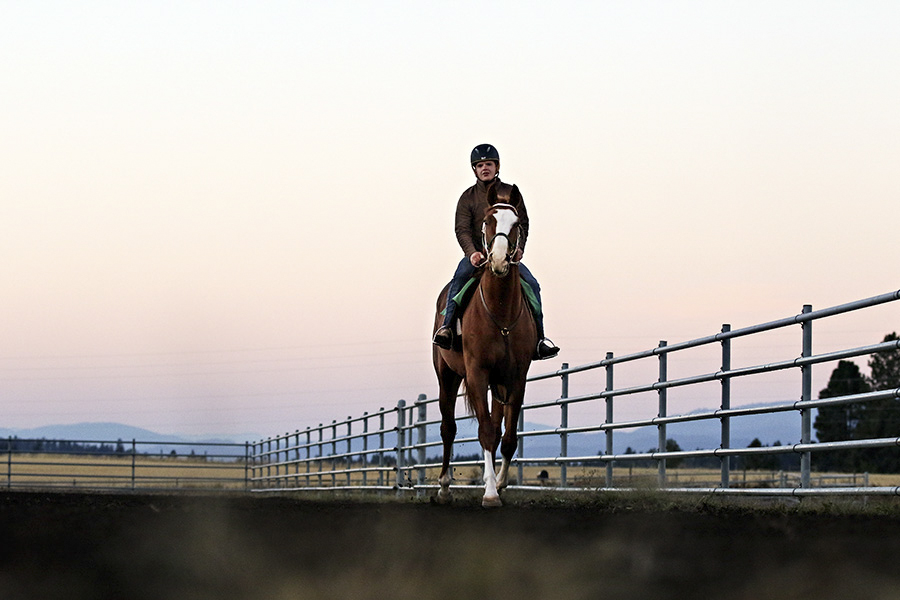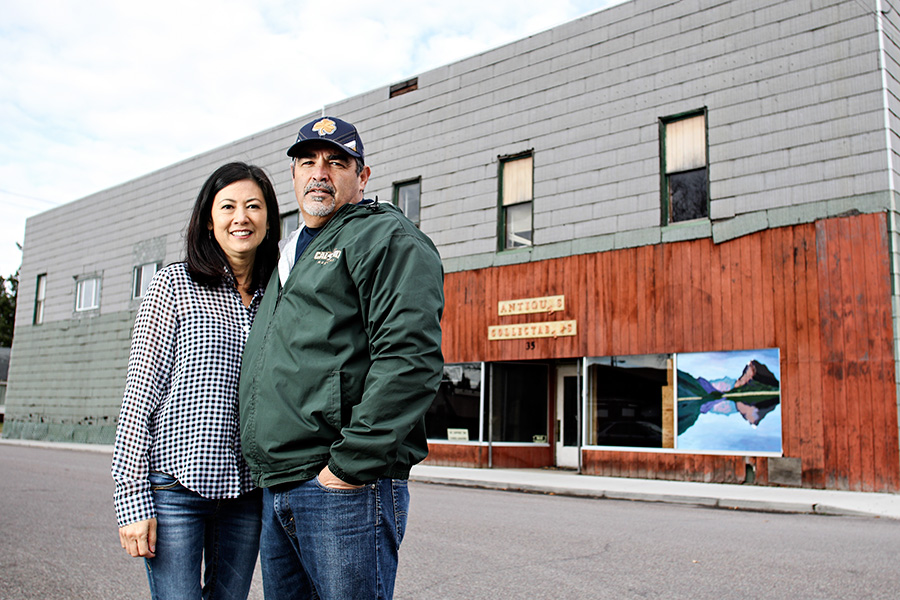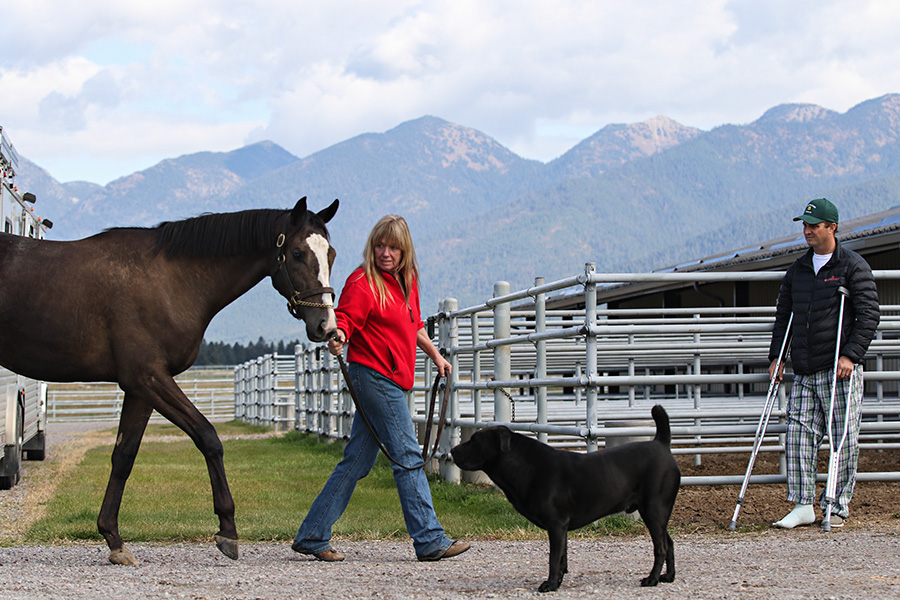Breaking the Best
With a world-class training facility in Bigfork, Mick Ruis is a rising star in the sport of horse racing with a stable of talented thoroughbreds that includes the early favorite in next year’s Kentucky Derby
By Dillon Tabish
Last weekend at Santa Anita Park in Arcadia, California, many of the nation’s fastest up-and-coming thoroughbreds competed in a premier race that set the stage for next month’s Breeders’ Cup, the final defining event of the horse racing season. It also provided one of the first real glimpses of potential frontrunners for next year’s Kentucky Derby.
Several races with dozens of horses hit the track on Saturday at the FrontRunner Stakes, but one in particular sent shockwaves through the sport: a Grade 1 competition featuring a 2-year-old colt named Bolt d’Oro.
Entering the last furlong of the 1 1/16-mile race, the smooth, swift, bay-colored horse flashed bright like a strike of lightning. His legs powered in unison as jockey Corey Nakatani ushered the horse’s confident stride down the final stretch.
“Bolt d’Oro is forging clear,” the race announcer proclaimed. “This is a high-caliber colt. We’re witnessing the emergence of a star.”
When the dust settled, Bolt d’Oro had won by more than seven lengths, a remarkable triumph that produced national headlines and considerable buzz throughout the world of horse racing. Mike Watchmaker, a horse-racing expert who writes for ESPN, declared the eye-opening victory as “easily the most impressive performance by a 2-year-old in North America so far this year.”
“It’s okay to get excited. Bolt d’Oro is worth it,” Watchmaker wrote.
The breakout victory earned the horse an automatic berth in the Nov. 4 Breeders’ Cup Juvenile race and cemented Bolt d’Oro’s status as the early favorite for the Kentucky Derby in May 2018.
It also prompted newfound curiosity among those who are unfamiliar with Bolt d’Oro’s owner, a relatively new name in the sport with a relatively unconventional method for preparing thoroughbreds for high-priced competition.
Mick Ruis, a high school dropout who became a millionaire in the scaffolding industry, is well known in Northwest Montana as a serial investor who has spent heavily on the revitalization of Columbia Falls. Now he’s becoming a household name among the highest ranks of horse racing, and he’s putting the Flathead Valley on the map as a world-class training ground.
Ruis (pronounced Roo-is) made a name for himself in the Flathead Valley two years ago when he abruptly emerged as a generous benefactor who spent millions in a matter of months on ambitious redevelopment projects in Columbia Falls.
He built the 25,000-square foot Cedar Creek Lodge, providing the town its first and only prominent hotel. After completing the $10 million hotel and convention center, he sold it to Xanterra Parks and Resorts.
He bought a lineup of properties in downtown that were either teetering toward blight or already dilapidated, such as the former First Citizens Bank, DaVall Building, Park Merc Building and two vacant lots behind the Merc, and has been developing them into apartments and retail spaces. A $3 million, 18-unit apartment complex is slated to break ground this week on the former DaVall Building property.
Ruis also purchased the Bandit Bar and Saloon, renovated it and recently sold it to Pat Carloss, the owner and general manager of Tupelo Grille in Whitefish.

Even smaller yet notable needs have garnered Ruis’ support, such as the $45,000 lighting equipment and scoreboard donated for the high school soccer field.
His love of Columbia Falls and the Flathead Valley is rooted in his origin story. Ruis grew up in a poor family in El Cajon, a relatively small city in San Diego County, California. He dropped out of high school midway through his senior year and found a job at a local scaffolding company.
After a few years, he moved to the Flathead Valley where his sister was living. With $6,000 to his name and three children as a divorced single dad, 27-year-old Ruis bought his first piece of property, the Nord Apartments in Columbia Falls. Ruis and his children lived in one of the rooms of the apartments with only a mattress and a fax machine. That’s where he founded his first construction company. By the late 1990s, Ruis had become a successful contractor who earned a reputation for hard work and integrity.
During this time, he met his future wife, Wendy, who was living in Whitefish. They moved their family to San Diego in 1999 to grow his company in the shoring and scaffolding industry. Within a few years, it was one of the largest businesses of its kind in the nation.
In 2003, Ruis sold the company for $2.5 million, and that’s when he discovered horse racing. He bought horses that were bred and trained on his California farm while his son, Mick Jr., became a successful jockey. Ruis dabbled in the sport for a couple years before he was drawn back into the scaffolding business, joining American Scaffold, a San Diego company with six employees.
Ruis became the sole owner of American Scaffold and developed it into one the largest scaffolding operations in the U.S. and the largest provider for the U.S. Navy.
Ruis sold a majority ownership of the company, and then he and Wendy were drawn back to where it all started. They returned to the Flathead Valley and made it their home away from home.
That’s also when Mick’s love of horse racing resurfaced in a remarkable way.

It’s in the eyes. It’s also in the legs: muscular joints that provide a certain swagger.
Those are a few of the traits that Ike Green looks for when he’s examining yearling horses.
“Pedigree is a big part of it for some people,” Green said. “For me it isn’t.”
Green, a lifelong trainer who breaks and exercises horses for a living, met Ruis a decade ago when Mick Jr. was a jockey.
Ruis liked Green’s abilities and trustworthiness. He also liked Green’s eye for talent.
Last year, Ruis decided he was ready to retry his hand at horse racing. He discovered an 80-acre ranch on the outskirts of Bigfork near the foothills of the Jewel Basin. The estate was fully equipped with stables, outdoor arenas and just about every amenity needed to raise and train horses, including heated floors. The indoor arena is 125 feet wide and 285 feet long.
It felt meant to be and was the perfect place for Ruis to build his horse racing empire.
Ruis purchased the property, now called Ruis Ranch, and asked Green and his wife, Aidan, to move there full-time to break and train young thoroughbreds before sending them to California, where they prepare to race.

Ruis flew the Greens to Kalispell last July to introduce them to the ranch. As fate would have it, it was an unexpected homecoming.
“It’s kind of strange. When we were flying up here to look at the ranch in Bigfork, I said, ‘I haven been here in 20 years,’” Green said recently. “Mr. Ruis said, ‘Oh you’ve been here before?’ I said, ‘This is where I went to school.’ He didn’t even know it.”
Green graduated from Flathead High School in 1997 and learned his skills as a kid growing up at the Flathead County Fairgrounds. Now, in much the same way that Ruis has returned to his roots, Green is back where it all started as Ruis’ top trainer.
Green regularly attends horse sales across the country, seeking the next great racehorse for Mick’s racing operation, named Ruis Racing.
Last year a yearling colt caught Green’s eye right away. He encouraged Ruis to purchase it, and Ruis listened, spending $630,000. The young horse shined in Green’s eyes for its athletic prowess but its pedigree was also unavoidable. The horse’s father was a prized stallion named Medaglia d’Oro that was born in Kentucky and spent his youth on a farm in Great Falls. In the early 2000s, Medaglia d’Oro was one of the top-ranked 3-year-olds in the nation and is now one of the most sought-after stallions in the world.
Green analyzed hundreds of horses at the sale and Ruis purchased several, but that one bay-colored colt stuck in his mind.
“He just looked like a man among boys to me,” Green said of the colt.
“I try to look for a fast horse that can run all day, that’s made out of steel.”
In August 2016, Ruis flew his first set of yearling horses up to Montana for Green and his team to break and train at the Bigfork ranch.
That same horse stood out once again as it ran through the mountain meadows.
“When I turned him out in the pasture and he ran, he barely picked his feet up,” Green said. “He just floats.”

Green’s wife, Aidan, had the daunting task of naming the horse, and she came up with a fitting one. His first name is Bolt after Jamaican sprinter Usain Bolt and the second part is named after his father.
Bolt d’Oro spent five months training in Bigfork. Green and his team broke the colt with daily exercising and routines, testing the abilities of the animal while teaching it how to tap into its natural athleticism and power. When breaking and training a yearling, the Ruis crew will ride horses for upwards of 45 days before turning them out to pasture for a month, allowing them to rest and recuperate. Then they transition the horses into a conditioning and exercise program before they’re ready to head to California for primetime.
“Most people think we’re crazy for sending our horses to Montana,” Green said.
Most breeders send their thoroughbreds to more populated, warm-weather places like California or Florida to train. Not only is Montana off-the-beaten path in many respects; it’s also home to cold, harsh weather for a good part of the year.
Green likes it that way.
“With racehorses nowadays, I notice these guys just try to take them straight to the track and (the horses’) minds are not ready yet,” Green said. “Our horses are used to everything when they get to the track. In Montana they see a bit of everything. They’ve seen deer and elk and tractors. Nothing seems to bother them when they get to those big races. I think that’s really good for them.”
And, as Green likes to remind people, horses enjoy cold weather, and lower temperatures help prevent disease.
The Greens also appreciate the man behind the effort.
“When you’re an owner and a trainer, you have a lot more care for the horses. A lot trainers don’t own the horses, and they want to run them as soon as they can because that’s how they get paid,” Aidan Green said. “But with Mick owning and training, he’s got the horses’ best interests at heart and wants a long-term career out of them.”
She added, “Mick doesn’t do this for the money. It’s his love. He’s at the barn every day at 4 a.m.”

Last week Ruis flew in another herd of yearlings — 14 all together — from Kentucky to Kalispell. The latest group put the total number of horses either training or vacationing at the Ruis Ranch above 50.
For Ruis, horse racing isn’t a job; it’s a passion project.
“I’ve got the bug,” he told the Beacon last week. “It’s the most exciting thing. It’s like your kids in a sporting event — the adrenaline. It’s the highest of highs and the lowest of lows.”
Ruis is only in his second summer as an owner, and a surprising amount of early success has followed him. This year he has 13 wins among various horses and more than $1.4 million in earnings. He also has a rising star in Bolt d’Oro, who made his racing debut this season.
Excitement is already surrounding Ruis and his prized colt. But the team knows the sport is a rollercoaster ride from start to finish.
There are roughly 20,000 thoroughbred yearlings born every year, and only half make it into an actual race. At the Kentucky Derby, only 20 horses line up. The list of variables leading up to that moment is endless.
But there’s no denying: the odds for Bolt d’Oro are improving by the minute. Last week’s win in California provided points for next year’s Derby, and success at the Breeders’ Cup would add even more promise to the prospects as May approaches.
“It would be nice to keep this momentum going,” Ruis said. “It’s exciting for us and for Montana.”
